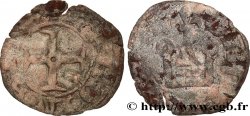Obverse
Obverse legend : KAROLVS* DI* GR - FRANCORV* REX, (PONCTUATION PAR DE SIMPLES ROSES À CINQ PÉTALES).
Obverse description : Charles V, couronné, debout sous un dais gothique accosté de lis, portant une cotte d'armes fleurdelisée par-dessus sa cotte de mailles, tenant une épée de la main droite (un annelet à la garde) et la main de justice de la gauche.
Obverse translation : (Charles, par la grâce de Dieu, roi des Francs).
Reverse
Reverse legend : + XPC* VINCIT* XPC* REGNAT* XPC* INPERAT, (PONCTUATION PAR UNE ROSE À CINQ PÉTALES).
Reverse description : Croix tréflée avec quadrilobe anglé en cœur contenant un point, cantonnée aux 1 et 4 d’un lis couronne, aux 2 et 3 d'une couronne, dans un quadrilobe anglé accosté de lis.
Reverse translation : (Le Christ vainc, le Christ règne, le Christ commande).
Commentary
Historical background
CHARLES V LE SAGE / THE WISE
(08/04/1364-16/09/1380)
After the disasters of Philip VI and John II, the reign of Charles V is a brief moment of recovery of the kingdom of France. Born in Vincennes in 1337, son of Jean II le Bon and Bonne de Luxembourg, Duke of Normandy then regent of the kingdom during his father's captivity, Charles V ascended the throne in 1364 with already a long experience of government. He had to fight the war on several fronts. In Brittany, the Treaty of Guérande (1365) recognized the victory of Montfort's party. In Burgundy, at the extinction of the old Capetian dynasty, the duchy passed to Charles's brother, Philippe le Hardi. Finally, in Cocherel, in March 1364, Du Guesclin defeated the troops of Charles of Navarre. The same month, Charles V was crowned in Reims. In March 1365, the Navarrese made his peace with the king. It was also necessary to fight against the large companies which ravaged the kingdom. A certain number were driven away by the Castile expedition (1366-1367), where the Franco-English struggle continued.. Du Guesclin, taken prisoner in April 1367, fell into the hands of the Black Prince, who freed him for ransom the following year. However, the cities of Aquitaine, crushed by taxes, revolted against the Black Prince (1368). On November 30, 1369, the King of France decided to confiscate the duchy. Immediately, Edward III resumed the title of King of France, abandoned in 1360. The French reconquest was powerfully facilitated by the tax system that Charles had put in place during the previous decade.. The navy was reconstituted and raids launched against English ports. To the great cavalcades of the English captains, the French opposed fortifications and the establishment of garrisons. Constable in 1370, Du Guesclin was placed at the head of a professional army which replaced the feudal host. Artillery makes its appearance in sieges. The treasurers of wars ensure the regular payment of the troops. In 1369, Louis d'Anjou took over Rouergue, Quercy and part of Périgord and Agenais. In 1370, the rest of these provinces fell to the French. Robert Knolles' ride into northern France was fruitless, the royal troops refusing to fight.. In 1372, Poitiers and Saintes were taken, Aunis and Angoumois were annexed to the royal domain, Poitou given to Jean de Berry. In 1373, Edward III charged his son John of Lancaster with a great ride from Calais to Bordeaux. A truce was concluded in 1375. The Black Prince died in 1376, Edward III in 1377. His successor Richard II was only twelve years old. He only had Bordeaux, Bayonne and Calais left on the continent.. France therefore emerged victorious from the confrontation: in January 1378, Charles V received with great pomp in Paris the Emperor Charles IV of Luxembourg and his son Wenceslas.. The Capetian kingdom was confirmed in its status as the first power in the West. A wise and prudent administrator, Charles V reorganized the army and the financial administration. It establishes fouages and aids, permanent de facto taxes which were introduced to contribute to the war effort. The royal army had also become permanent, made up of companies with captains appointed by the king; supplemented by a fire artillery and a navy. A great builder, he had the Hôtel Saint-Pol built, rebuilt the Louvre and the Château de Vincennes.. A scholarly prince, he built up a superb library and encouraged scholars. In 1373, Charles V had brought the royal majority at the age of thirteen.








 Report a mistake
Report a mistake Print the page
Print the page Share my selection
Share my selection Ask a question
Ask a question Consign / sell
Consign / sell
 Full data
Full data






